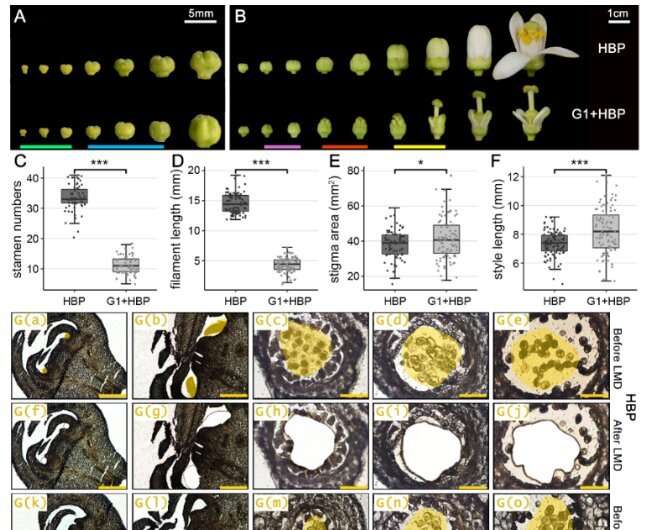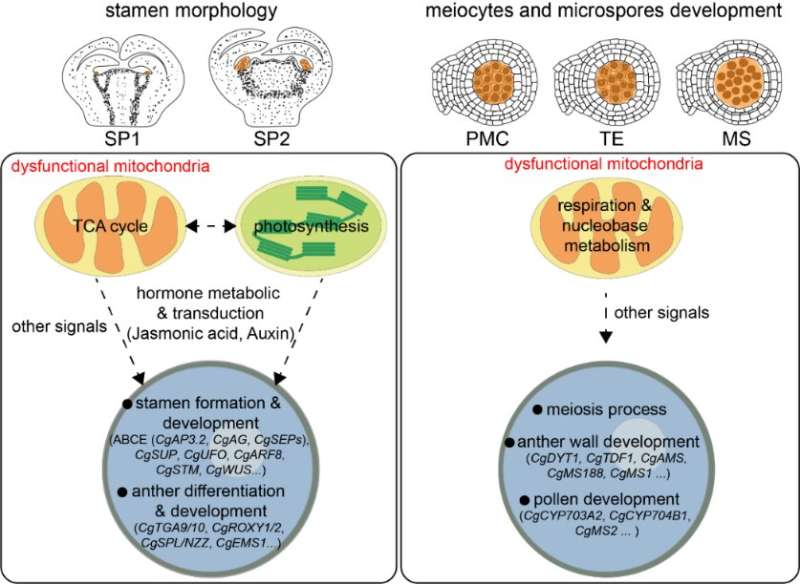Nucleo-cytoplasmic interaction in seedless cybrid citrus

Male sterility is important for seedless citrus breeding. A long juvenile phase and nucellar polyembryony leads to low efficiency of hybrid breeding in citrus. The Citrus research group in National Key Laboratory for Germplasm Innovation & Utilization of Horticultural Crops in Huazhong Agricultural University (HZAU) has worked in cell engineering and genetic improvement for more than 30 years. The research group has successfully regenerated seedless citrus cybrids including G1+HBP and G1+STY through somatic cell fusion. The method transfers mitochondrion of Satsuma mandarin (G1), a cytoplasmic male sterile (CMS) cultivar, to seedy pummelos (HBP, STY), which shortens the breeding cycle for at least 20 years.
The mitochondrial genome of cybrid citrus (G1 + HBP) is from the CMS callus parent “Guoqing No. 1” Satsuma mandarin (G1), while the nuclear and chloroplast genomes of G1 + HBP are from the fertile mesophyll parent Hirado Buntan pummelo (HBP). The tree of G1+HBP resembles HBP, as well as fruit appearance and flavor, while G1+HBP showed typical male sterility including degenerated petals and stamens and aborted pollen, which resulted in seedless fruit.
The interaction of mitochondrion from CMS parent G1and nucleus from HBP might contribute to male sterility of G1+HBP. The male sterility candidate genes of the cybrid were identified using comparative analysis of omics and the mitochondrial genome, while the interaction pattern of mitochondrion and nuclear in this cybrid is still unknown.
This result has been published in Horticulture Research, titled “Spatiotemporal profiles of gene activity in stamen delineate nucleo-cytoplasmic interaction in a male-sterile somatic cybrid citrus.”
In this study, stamen organ and cell types at five important stages were confirmed by morphology observation and collected using laser microdissection. The spatiotemporal expression of genes in stamen of citrus were profiled by RNA-Seq.
This study identified differentially expressed genes (DEGs) related to stamen development in stamen primordia, meiocytes and microspores of G1+HBP. ABCE model genes were systematically analyzed, and B class gene CgAP3.2, a newly identified AP3 homologous in citrus, was selected as the candidate gene involved in stamen development, according to gene expression and a protein interaction assay.
The dysfunction of mitochondria in G1+HBP was elucidated, and nucleo-cytoplasmic interactions were proposed based on GO enrichment analysis of DEGs, measurement of hormones and primary metabolism content of the flower bud. In stamen primordia of G1+HBP, the jasmonic acid (JA) and auxin (IAA) metabolism were disrupted. In addition, the expression pattern of DEGs related to JA metabolism pathway, photosynthesis and tricarboxylic acid cycle (TCA) was consistent.

The exogenous mitochondrion might disrupt IAA metabolism directly, and affect JA metabolism indirectly through the abnormal photosynthesis in chloroplasts, which together changed the expression of stamen primordia development related genes. Respiration and mitochondria related cellular components were disrupted in meiocytes of G1+HBP, and mitochondrial nucleobase metabolism were disrupted in microspores of G1+HBP, which together indicated that the dysfunction of mitochondria might affect meiosis and microspores development and resulted in pollen abortion.
This study proposes a potential nucleo-cytoplasmic interaction network in the stamen of citrus, which supports mechanisms disclosure of cytoplasmic male sterility in citrus.
More information:
Nan Jiang et al, Spatiotemporal profiles of gene activity in stamen delineate nucleo-cytoplasmic interaction in a male sterile somatic cybrid citrus, Horticulture Research (2023). DOI: 10.1093/hr/uhad105
Citation:
Nucleo-cytoplasmic interaction in seedless cybrid citrus (2023, July 7)
retrieved 8 July 2023
from https://phys.org/news/2023-07-nucleo-cytoplasmic-interaction-seedless-cybrid-citrus.html
This document is subject to copyright. Apart from any fair dealing for the purpose of private study or research, no
part may be reproduced without the written permission. The content is provided for information purposes only.
For all the latest Science News Click Here
For the latest news and updates, follow us on Google News.

